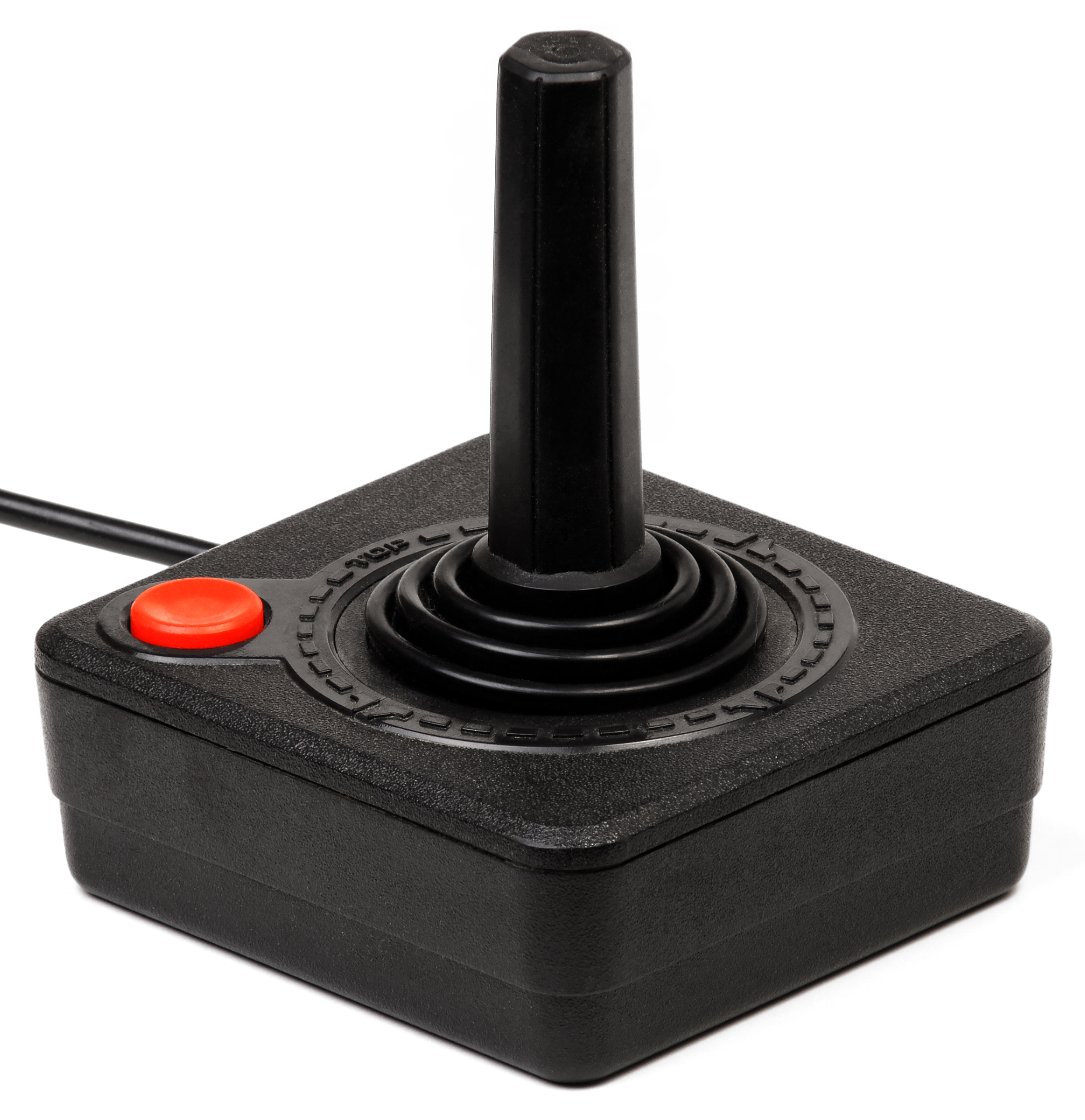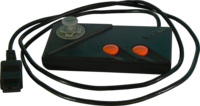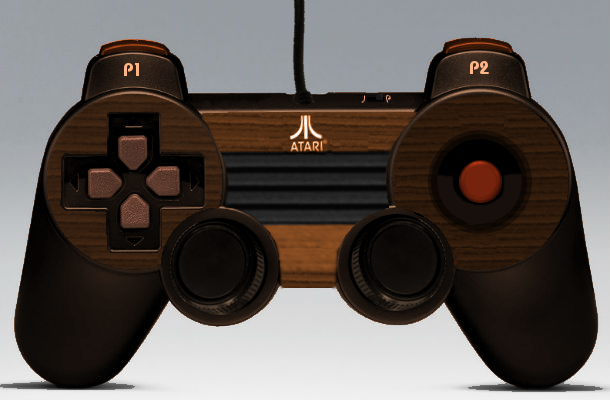Quick disclaimer: I love using the original Atari joystick. It may not be the most ergonomically efficient or functionally convenient controller, but it is a classic. Nothing could ever replace it. I would never want anything to replace it, even if something could.
With that said, let me also state that I find the Atari joystick annoying to use at times. If you're unfamiliar with it, you (a) have never played video games or (b) are just wilfully ignorant. Here's a picture, in any case:
Source: Wikipedia
We'll put aside the fact that it's inherently right-handed (unless you, as I have, take one apart and re-wire it to be left-handed) and focus on its shape. It's a box, whose corners, although rounded, are going to cause discomfort no matter how you hold it. It is also lightweight, meaning that it is impractical to set it down on a table and use it as you would an arcade stick. The design is simple and straightforward, but it could use some work.
In fact, it wasn't long after the introduction of the Atari VCS that third-party joysticks emerged in abundance. The fact that the 9-pin controller port used by the Atari VCS was adopted as something of a standard by machines from Commodore 64 to the Sega Genesis with near 100% compatibility meant that there was always an alternative. Even now, a collector can find numerous different joysticks, all trying to improve upon the basic design.
One of the big drawbacks of the Atari controller was a function of its technology: the directional controls were all discrete, not analog. There were four separate signals for up, down, left, and right, and none of them had any gradation of intensity. Therefore the console could not tell how far you were pushing the joystick in a particular direction, only what direction(s) you were engaging.
Source: robotroom.com, via Google Image Search.
See those button-looking things up there? The bottom of the joystick has four plastic nubs on it. Depending on how you tilt the stick, one or two of those will make contact with the dome switches and send the appropriate signal to the console. The fire button does the same thing for the switch in the upper left.
Of course the Atari VCS did have analog controllers: the paddles.
Source: Wikipedia
These controllers, bundled in pairs, are incredibly responsive because they work via analog signals (I'm simplifying a bit, as I'm not an electrical engineering expert and it's not crucial to my point here). I find it incredible and disappointing that there really weren't third-party variants to these.
How did one port support both joystick and paddles? Well, that's a bit complicated, but essentially either controller type didn't use all 9 pins on the controller port. I found a site that shows the mappings of all these controllers, which those of you curious enough may want to examine. Also, if you read it you'll understand a bit more when I finally get to my point further down the page here.
There is another style of controller, however, besides the joystick: the gamepad, or joypad (depending on your term of preference). This is the controller people most associate with the Nintendo Entertainment System, and it's probably one of, if not the most important advances in controller design. Moving the directional control to a small pad able to be maneuvered by one thumb frees up the coordination of the other hand and greatly reduces hand/wrist strain.
Those who collect for the Atari 7800 ProSystem are probably aware of the deficient design of its standard controllers, based loosely on the joystick design. Some are aware that there was a different controller packaged with the system for European customers:
If you have an Atari 7800, get one of these. Also got this pic from Wikipedia.
Looks a bit like an NES controller, and works much, much better than a joystick (especially if you remove the little joystick thing on top of the directional pad). It's no surprise that from the NES forward, joysticks were ditched in favor of gamepads.Leap forward a bit to 1997, when Sony released the Dual Analog Controller for its PlayStation console.
Source: Wikipedia. Again.
Now you say to me, "JT, you feeble-minded protozoan! The Nintendo 64 had a controller with both analog stick and d-pad a year earlier!" And so it did.
Source: Wikipedia...boy I'm saying that a lot...
The picture above illustrates why I'm ignoring it for the purposes of this post. I've heard the arguments in favor of the N64's controller layout, but as far as I'm concerned it is an over-complicated, awkward mess that requires an uncomfortable shift in grasp to switch from the d-pad to the analog stick. We good on that point? Okay.
So with Sony's Dual Analog controller (and its descendants, the DualShock line), we first got a handheld controller that allowed easy access to both directional buttons and analog controls. Moreover, its design keeps the hands comfortably placed all during use. Truly remarkable.
By the way, if you want more love-spewing in Sony's direction from me, please see one of my earlier posts, wherein I also tackle the topic of video game controllers.
Are we getting back to your main point yet?
Yep. Here we go. Here is my proposal for the next step in Atari controllers.Another disclaimer: I'm not an electrical engineer, and I don't even play one on television. I've never soldered anything in my life, nor do I have the resources or know-how to build electronic components. But I have done a bit of research on this, and I have at least tinkered with Atari controllers (to the extent, as I mentioned earlier, of turning one of my joysticks left-handed), so what I am proposing is, so far as I know, theoretically feasible.
So just check it out, at least:
So professional...such amazing skill...
Controller features
- Woodgrain finish with ridges...because it must. Also, the Atari logo.
- Comfortable grip to reduce hand strain during long gaming sessions.
- The directional buttons can be mapped to the same outputs as for the joystick.
- In place of analog sticks, my mock-up here has two analog thumb wheels, basically miniature versions of the wheels on the paddle controllers. Left wheel for Paddle 1, right for Paddle 2.
- Single red button on the right-hand side. I love how simple and uncomplicated Atari controllers can be. You'd be surprised what you can do with just one button.
- P1 and P2 shoulder buttons. This is where it goes a bit onto more shaky territory, although I still believe it should be doable. Because paddle games for the 2600 didn't use a joystick for movement (by definition), they didn't need actual direction buttons. Therefore, paddle controllers use the same pins for "Fire 1" and "Fire 2" (the red buttons on the side of the paddle controllers) as the joystick would use for "Right" and "Left", respectively. But even though very few paddle games have a single player using both paddles (Bumper Bash is the only one that comes to mind), you don't want to move your thumb from the wheel to the d-pad to fire. This is the beauty of shoulder buttons. Therefore, these buttons should somehow hook up to the same place as the right and left d-pad buttons.
- J/P selector switch (on top of controller). This I thought would be a great way to make sure one set of controls doesn't interfere with another. When set to J, it's in "Joystick" mode, and the shoulder buttons do nothing. Set it to "P" mode (i.e. "Paddle" mode), and the d-pad turns off, allowing the shoulder buttons to do their thing.
- Bonus points: Either in "J" mode or just naturally, the thumb wheels are depressable, and doing so automatically outputs the full voltage. That is, it's as if you were turning the paddle all the way. This is for compatibility with Atari 7800, where the pin that for the 2600 controller just means "fire" means "both buttons pressed," and the two buttons individually are controlled by the same pins as the paddle wheels (see this chart for reference). Therefore, when using it as an Atari 7800 controller, you just ignore the red button up top and use the paddle wheels for games where both buttons are used.
- Extra bonus points: This also gives you compatibility with Omega Race, which uses a special add-on to the joystick to give you an extra button, using the same method.
So there you have a controller that would meet both ergonomic and technical requirements. The only time you'd need to switch to another controller would be for multiplayer paddle games or Indy 500.
What I'm trying to say is, in effect, "Somebody please make this!"
Peace,
JT








Our friend... may we please tell you how pleased we are to see this exceptionally thorough post on this very necessary controller? May we also jump up and down excitedly, as if we are not "adults?" Nice work, JT! P.S. Love the TWO analog wheels and, of course, the woodgrain finish. Can we get this bundled up with the woodgrain PS4?
ReplyDeleteMy friends, it is with gratitude and utmost sincerity that I must echo your sentiments in their entirety. In a better world, Atari would never have died, and this is the controller we would have anyway. []
ReplyDelete